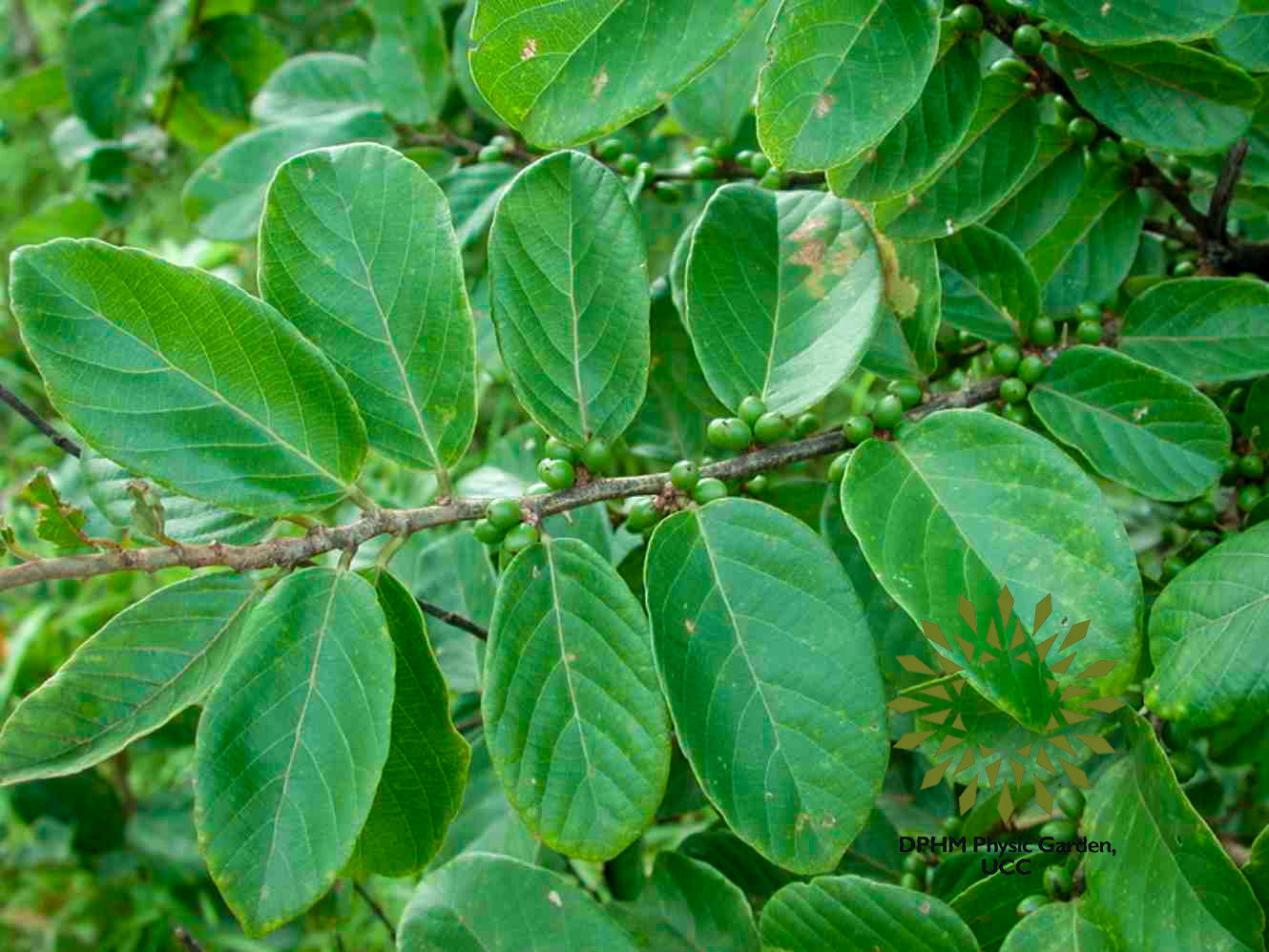CLASSIFICATION
Family: Euphorbiaceae
Genus: Bridelia
Species: Bridelia ferruginea
SYNONYMS
Bridelia micrantha var. ferruginea (Benth.) Müll.Arg
Gentilia chevalieri Beille
LOCAL NAMES
Twi: Opam fufuo,
Ga Adamgbe: Flatsho
Hausa: Kisni
Bridelia ferruginea is a plant that can grow between 4 to 15 meters in height. Its stem is scaly, non-latex producing, and may have spines, with grayish-brown bark that varies from smooth to rough. The plant’s simple, alternate leaves are broadly elliptical, with pinnate venation and entire margins, often featuring fine hairs. It produces small greenish or yellowish flowers in clusters, and its small, round fruits contain a single seed and are dark in color when mature, with medicinal uses. Bridelia ferruginea, a member of the Euphorbiaceae family, is an important plant species that is widely recognized for its medicinal and ethnobotanical uses across various African cultures. This shrub-like plant is commonly found in the savannah and rainforest regions of Africa, where it is able to adapt and thrive in diverse environmental conditions.
Bridelia ferruginea contains important bioactive compounds, such as flavonoids like quercetin and myricetin, as well as phenolic compounds like gallocatechin and caffeoylquinic acids, tannins that contribute to its astringent properties, and cardiac glycosides linked to heart health, while anthraquinones may vary in presence depending on the plant part and extraction method.
CHEMICAL STRUCTURE
It helps relieve joint pain and inflammation associated with arthritis and serves as a remedy for gastrointestinal issues like dysentery. The plant acts as a natural laxative for constipation and helps regulate blood sugar levels in chronic diabetes. It is also used for treating skin conditions, improving urinary and digestive health, promoting oral hygiene for infections and thrush, and treating wounds and insect bites. Additionally, it has been traditionally used as an arrow poison antidote.
PHARMACOLOGICAL ACTIVITIES
ANTI-INFLAMMATORY ACTIVITY
Bridelia ferruginea's stem bark water extract has strong anti-inflammatory properties, reducing inflammation in animal models. It effectively manages acute inflammation and granulomatous tissue formation, addressing both short- and long-term inflammation.
ANTIOXIDANT ACTIVITY
Bridelia ferruginea's flavonoids and phenolic compounds enhance its antioxidant properties, combating oxidative stress and cellular damage. The plant's ethanolic and methanolic extracts have strong antioxidant activity, neutralizing free radicals.
ANTIMICROBIAL ACTIVITY
Bridelia ferruginea extracts show strong antimicrobial activity against bacterial and fungal pathogens, suggesting potential as natural therapeutic agents. Stem bark extract inhibits Bacillus cereus, root extracts kill Salmonella typhi, Staphylococcus aureus, Escherichia coli, and Candida albicans.
Research indicates that Bridelia ferruginea can effectively lower blood glucose levels, supporting its traditional use in diabetes management. In alloxan-induced diabetic rats, the aqueous extracts significantly reduced blood glucose, especially at higher doses (800 mg/kg), showing strong antihyperglycemic effects. In fructose-induced diabetic mice, the tannin fraction of the hydro-ethanolic extract resulted in a 6.25% reduction in blood sugar by day 7 and 11.04% by day 14, demonstrating long-lasting antidiabetic properties.
ANTIPYRETIC AND ANALGESIC ACTIVITY
Bridelia ferruginea's aqueous extract has been shown to have fever-reducing and pain-relieving properties, similar to traditional antipyretic medications, in rats with yeast-induced pyrexia. Additionally, experiments in mice demonstrate significant analgesic effects from the stem bark extract, which reduces pain in a dose-dependent manner, suggesting both peripheral pain relief and potential central analgesic effects.
TOXICOLOGICAL PROFILE
Bridelia ferruginea toxicity studies showed mixed results, with no significant toxicity observed in Wistar rats at doses of 100-400 mg/kg, and low LD50 for oral and hot water extracts.
The study revealed that the combination of Bridelia ferruginea leaf extract and metformin in female rats significantly altered its pharmacokinetics, potentially impacting clinical outcomes.
CLINICALLY VALIDATED USES
Not reported
REFERENCES
Awodele, O., Amagon, K. I., Agbo, J., & Prasad, M. N. V. (2015). Toxicological evaluation of the aqueous stem bark extract of (Euphorbiaceae) in rodents. Interdisciplinary Toxicology, 8(2), 89–98.
Irobi, O., Moo-Young, M., Anderson, W., & Daramola, S. (1994). Antimicrobial activity of bark extracts of Bridelia ferruginea (Euphorbiaceae). Journal of Ethnopharmacology, 43(3), 185–190.
Mahomoodally, M. F., Jugreet, S., Sinan, K. I., Zengin, G., Ak, G., Ceylan, R., Jekő, J., Cziáky, Z., Angelini, P., & Angeles Flores, G. (2021). Pharmacological potential and chemical characterization of Bridelia ferruginea benth.—A native tropical african medicinal plant. Antibiotics, 10(2), 223.
Ngueyem, T., Brusotti, G., Caccialanza, G., & Finzi, P. V. (2009). The genus Bridelia: A phytochemical and ethnopharmacological review. Journal of Ethnopharmacology, 124(3), 339–349.
Olajide, O. A., Makinde, J. M., Okpako, D. T., & Awe, S. O. (2000). Studies on the anti-inflammatory and related pharmacological properties of the aqueous extract of Bridelia ferruginea stem bark. Journal of Ethnopharmacology, 71(1–2), 153–160.
Oloyede, O. I., & Babalola, S. O. (2012). Invitro antioxidant activity of ethanolic extract of bridelia ferruginea (stem bark). Academic Research International, 2(3), 246.
Owoseni, A. A., Ayanbamiji, T., Ajayi, Y. O., & Ewegbenro, I. B. (2010). Antimicrobial and phytochemical analysis of leaves and bark extracts from Bridelia ferruginea. African Journal of Biotechnology, 9(7), 1031–1036.
Sakyiamah, M., Brew-Daniels, H., Appiah, A., & Edoh, D. (2015). Herb-drug interaction: Effect of aqueous extract of Bridelia ferruginea leaves on the pharmacokinetics of metformin. Journal of Medicinal Herbs and Ethnomedicine, 1, 84–88.
Sanvee, S., Simalou, O., Tchani, G. W., Kagnou, H., Bakoma, B., Metowogo, K., Agbodan, K. A., & Kpegba, K. (2020). Antidiabetic activity of tannin fraction of Bridelia ferruginea (Benth) leaf extract on fructose-induced diabetic mice. Journal of Herbmed Pharmacology, 10(1), 68–74.
Yeboah, G. N., Owusu, F. W. A., Archer, M.-A., Kyene, M. O., Kumadoh, D., Ayertey, F., Mintah, S. O., Junior, P. A.-A., & Appiah, A. A. (2022). Bridelia ferruginea Benth.; An ethnomedicinal, phytochemical, pharmacological and toxicological review. Heliyon, 8(8).

INFORMATION, DATA AND PICTURES ARE COPYRIGHT OF DPHM, SCHOOL OF PHARMACY, UCC.

